We woke up early, about 6am, in order to get downstairs for a quick, light breakfast of pastries prior to our tour for the day. Our guide, Damien, arrived at 7:45am with a black touring van. As it was just the three of us that would be plenty of room! Being the talker in the family I took the front passenger seat (to his left) while Michelle was a seat just behind.
As we headed north through Dublin towards our destination he told us all about that part of the city, including the Spire, a tall stainless steel spire that replaced an earlier monument to Nelson, Nelson’s Pillar. The pillar was bombed by former IRA members in 1966 with a controlled demolition nearly a week later.
After a pleasant drive of just over a half hour we arrived at our first destination, Bru na Boinne, at about 9am. Pardon the lack of accents on Bru na Boinne as I haven’t a clue how to pull that off on my computer. It is an archaeological site of immense importance in a bend of the River Boyne. Now a UNESCO site, this area has three large Stone Age (Neolithic) tomb complexes, two in excellent shape. Only six hundred people a day are allowed to visit in order to limit the impact of tourism. The visitors’ center was beautiful and contained some really neat exhibits to set the scene.
About 9:30am we bade our guide farewell and walked along a very beautiful path over the River Boyne and to a small area where we were separated into two groups by the color of our wristband (purple, the best color) and boarded one of two busses. Our bus’ first destination was Knowth.
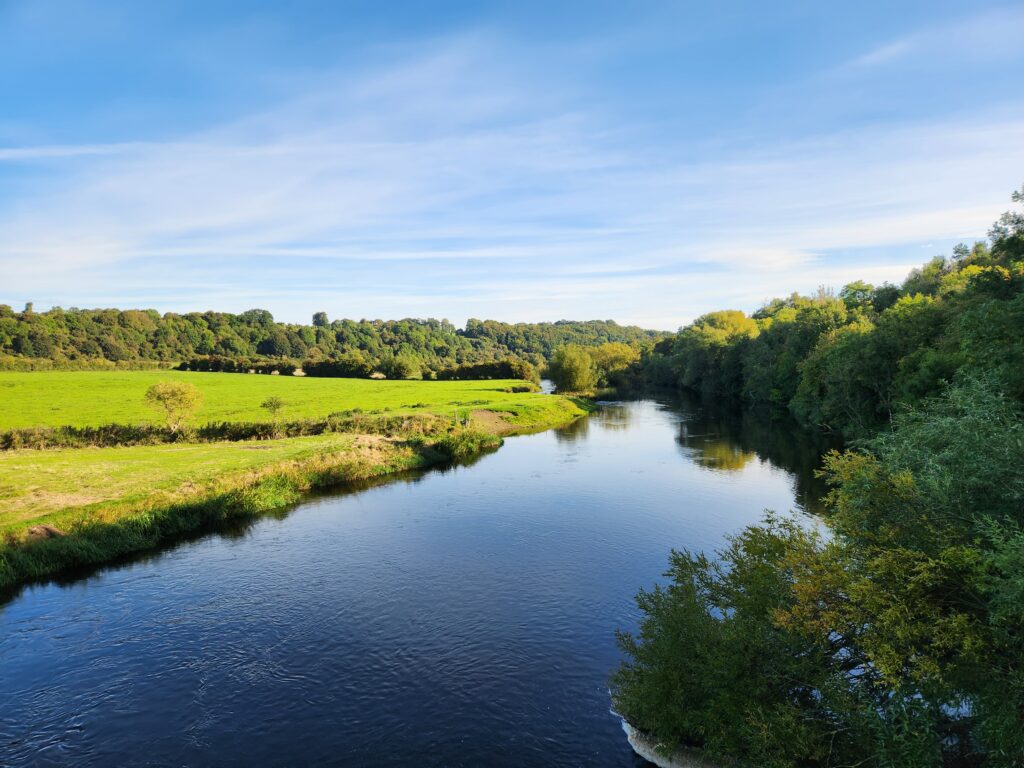
Knowth was constructed around 5000 years ago (3200BC) and consists of a large mound (forty feet high with a diameter of 220 feet) and nearly twenty smaller mounds of various sizes surrounding it. Inside the tomb two passages, both aligned east-west, penetrate to nearly the center but don’t connect. We didn’t get to go into these, however.
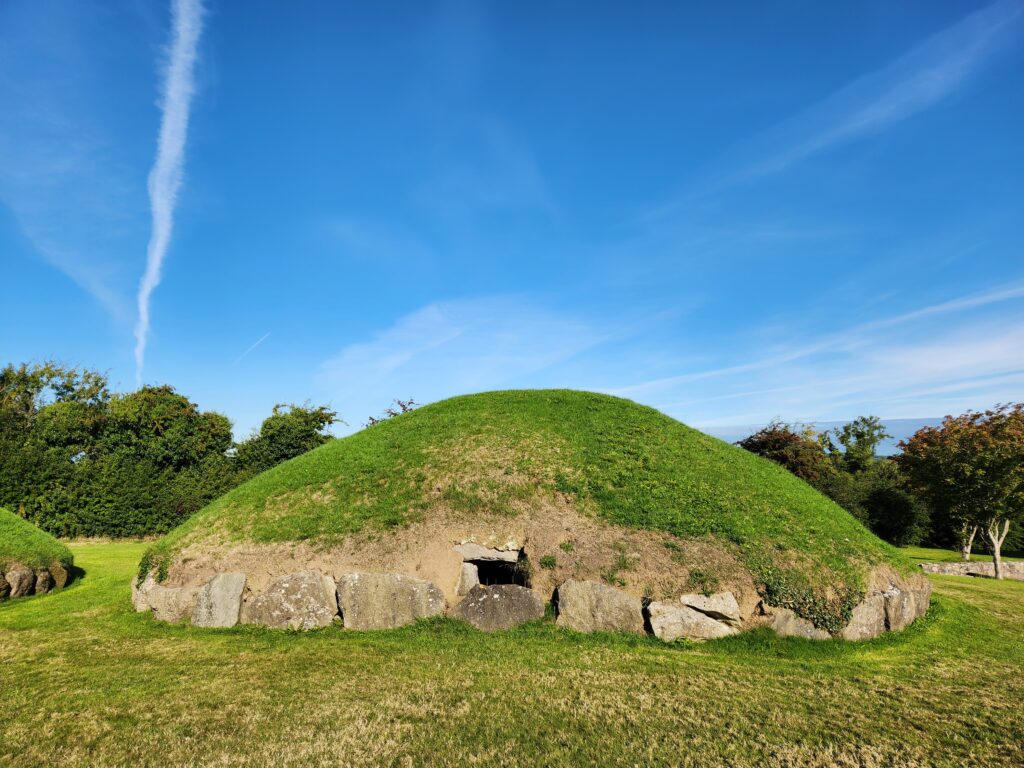
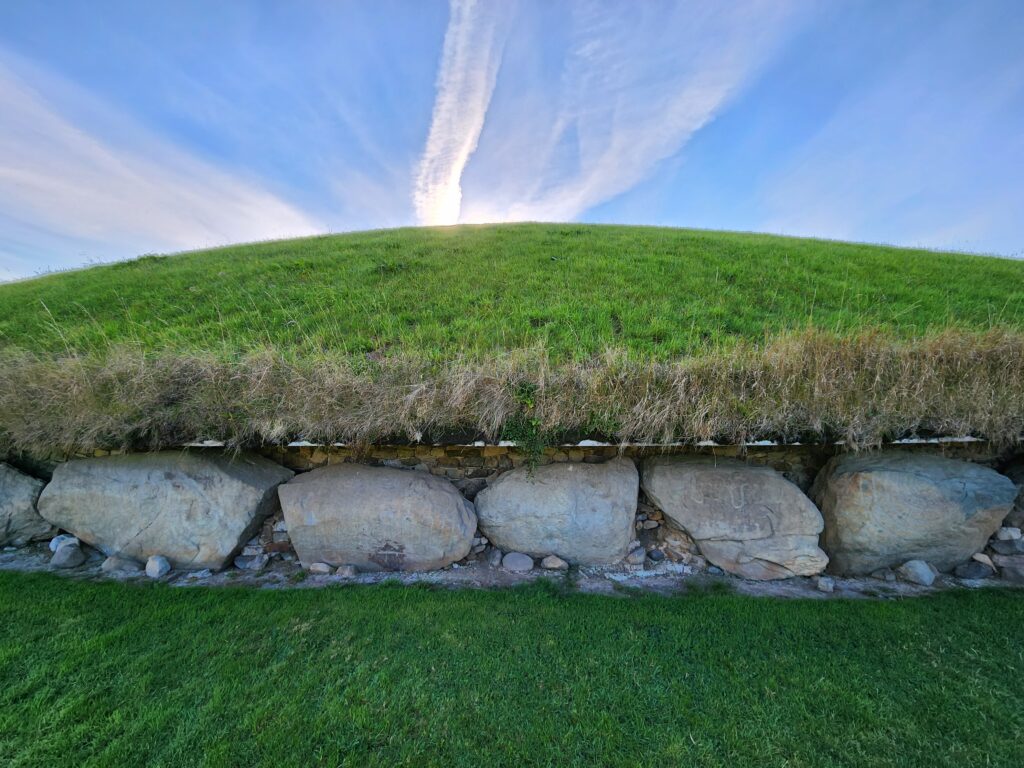
Our guide, Chavelle, provided an excellent orientation for about fifteen or twenty minutes. She mentioned that the tomb is surrounded by over a hundred kerbstones, many of which have megalithic art. In fact, Knowth alone contains more than a third of megalithic art found in Western Europe! The designs were mostly spirals and other line art and absolutely beautiful. The tomb was built over at least three generations with different types of stone coming from many miles away, some as far away as the Wicklow Mountains south of Dublin. The amount of effort and time required definitely pointed to the tombs being a burial place for the leaders of the community.
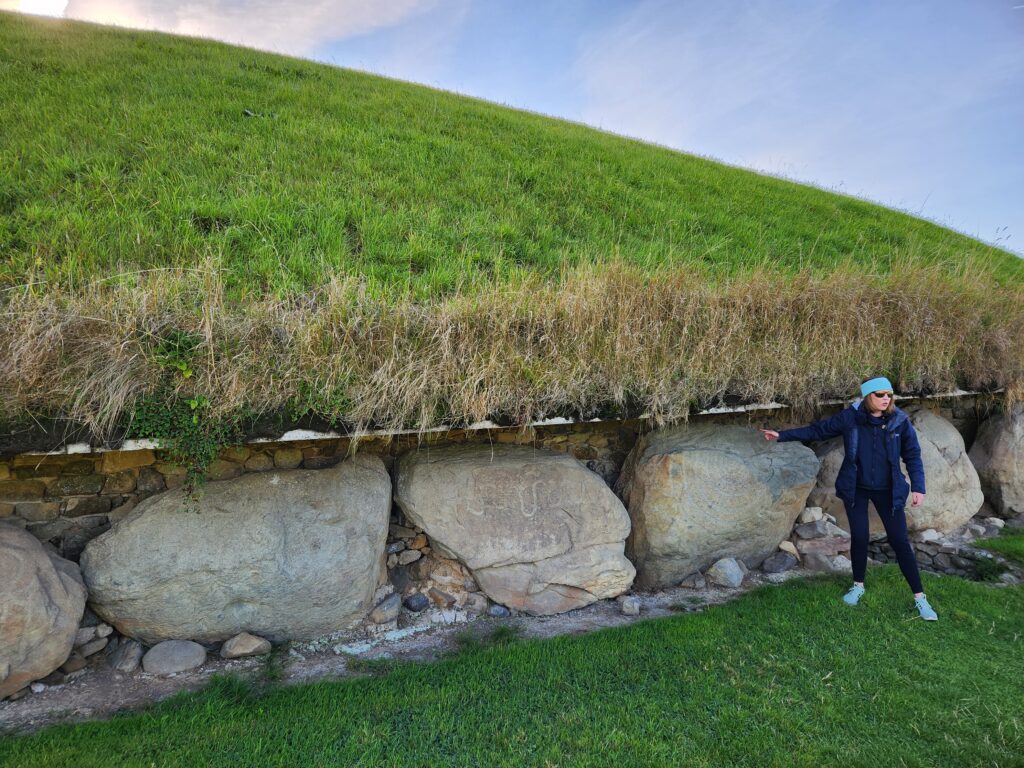
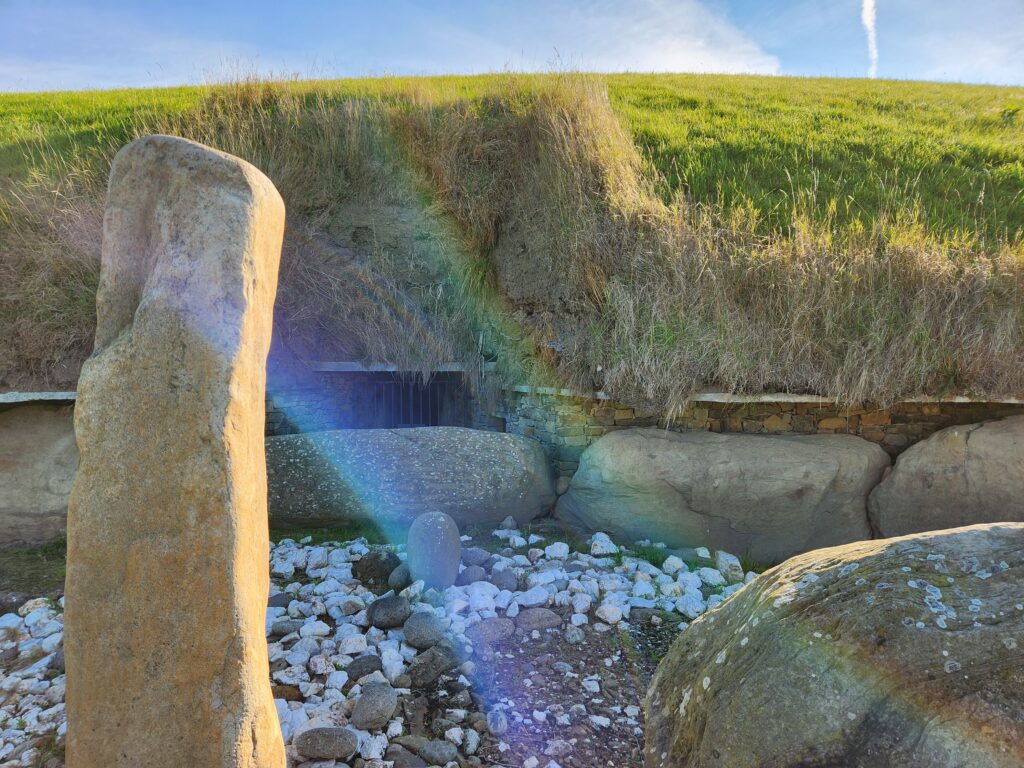
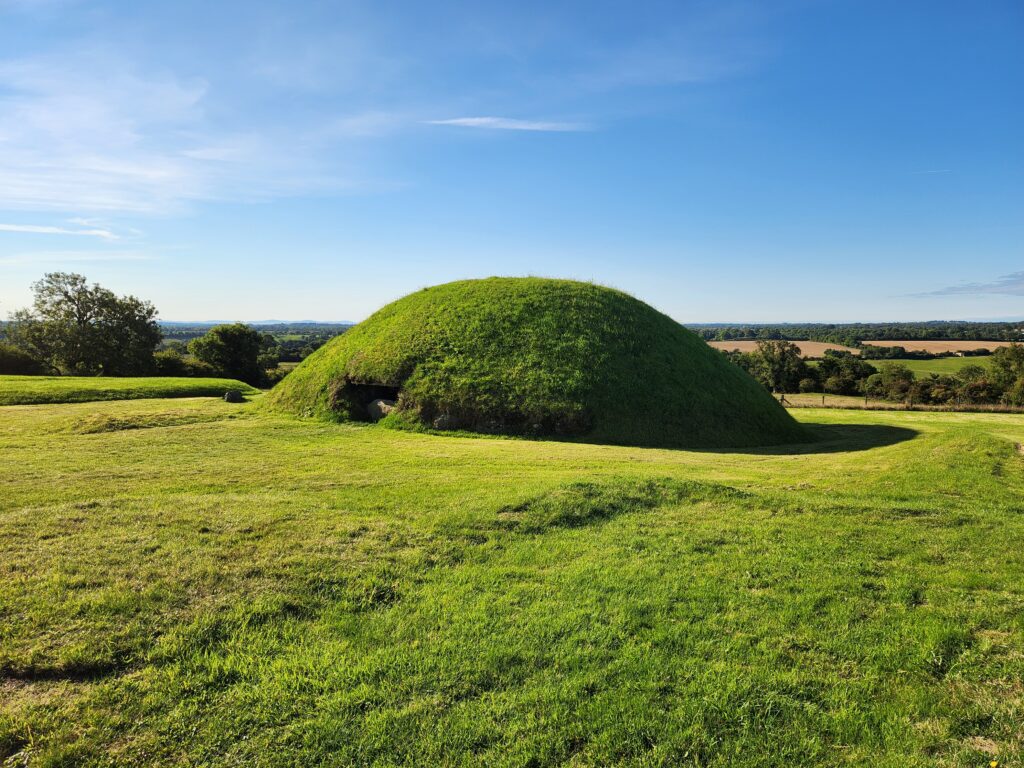
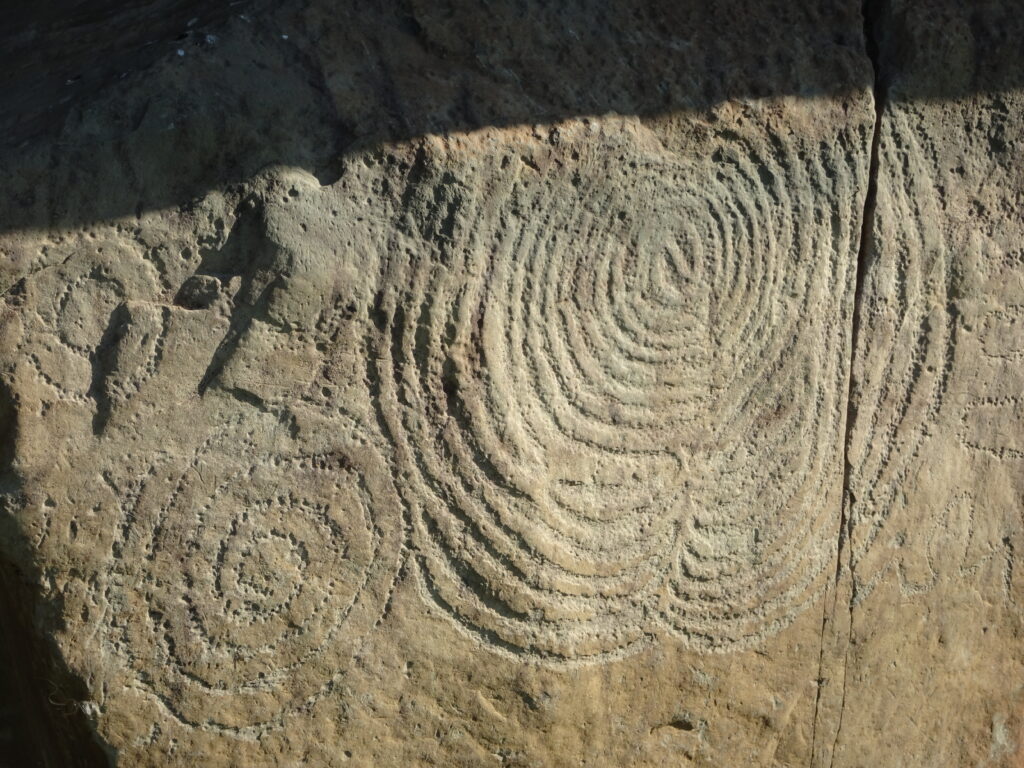
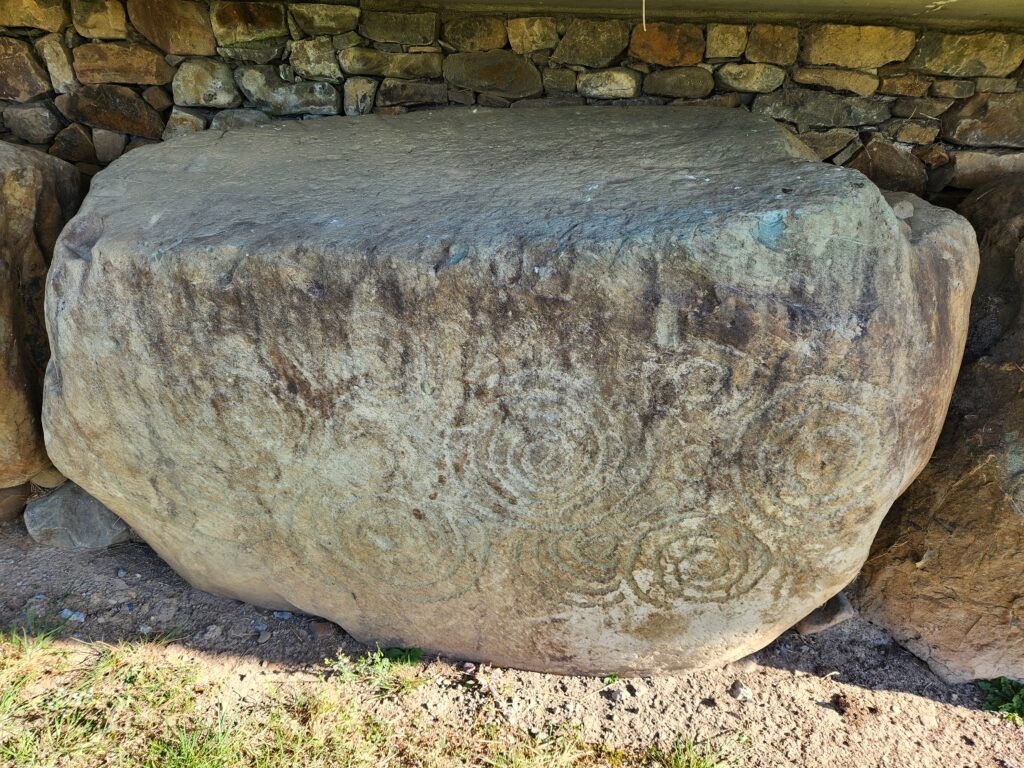
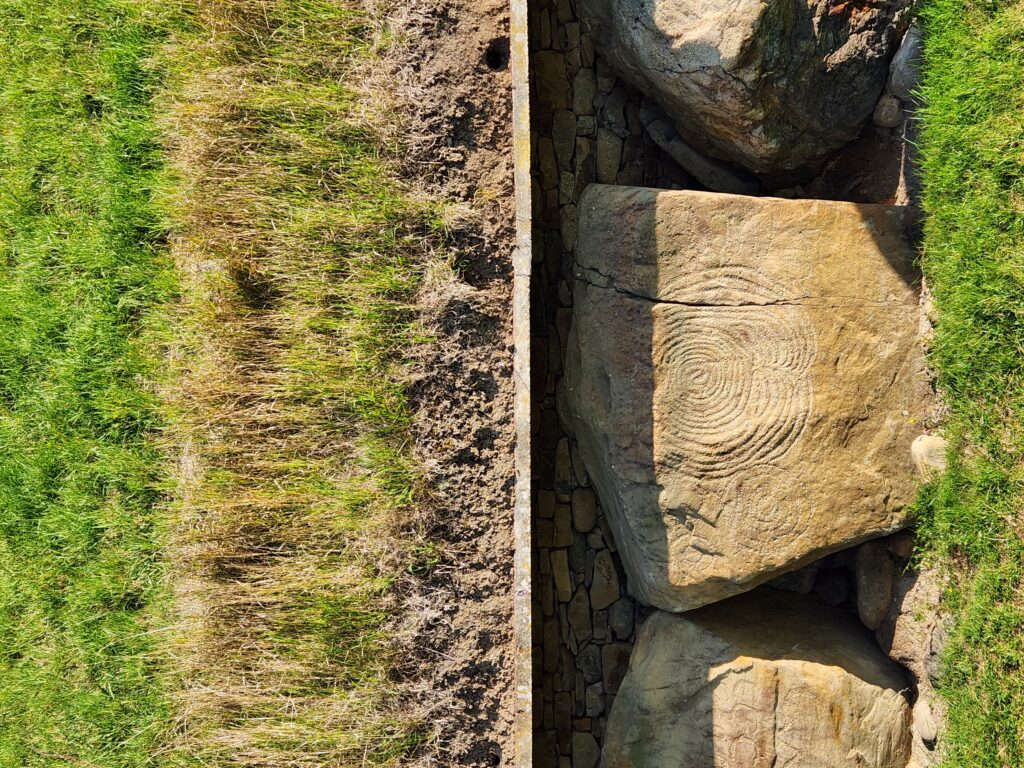
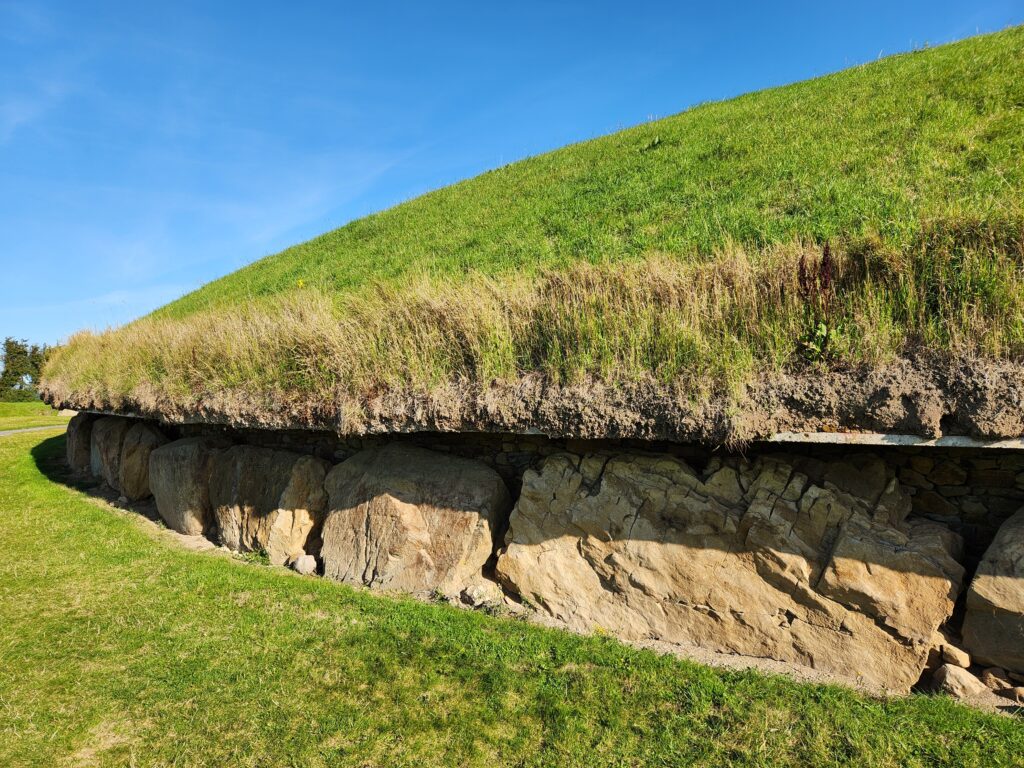
Her presentation over we were let loose for about thirty minutes. I climbed a stairway to the top of the tomb and was greeted by an amazing view of the entire River Boyne valley. It fell into disrepair for nearly two millenia until the late Iron Age when a hill fort was unknowingly built atop it. As it was an important area many sites are scattered throughout the region, some of them visible from atop Knowth. As it was a beautiful morning visibility was great!
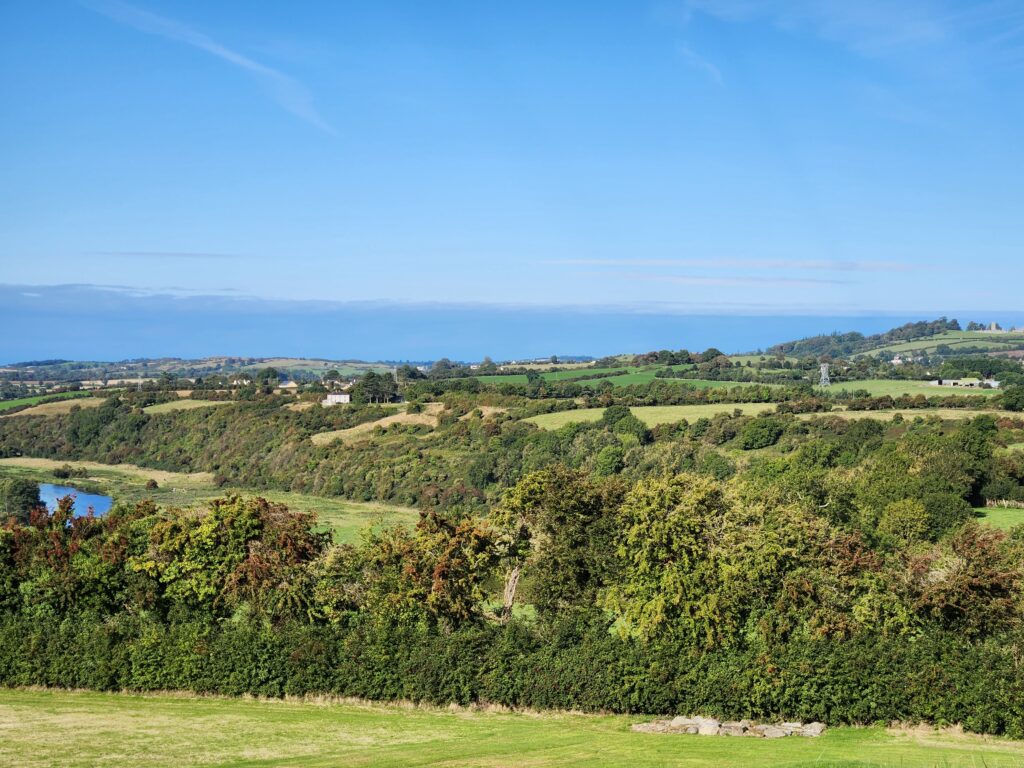
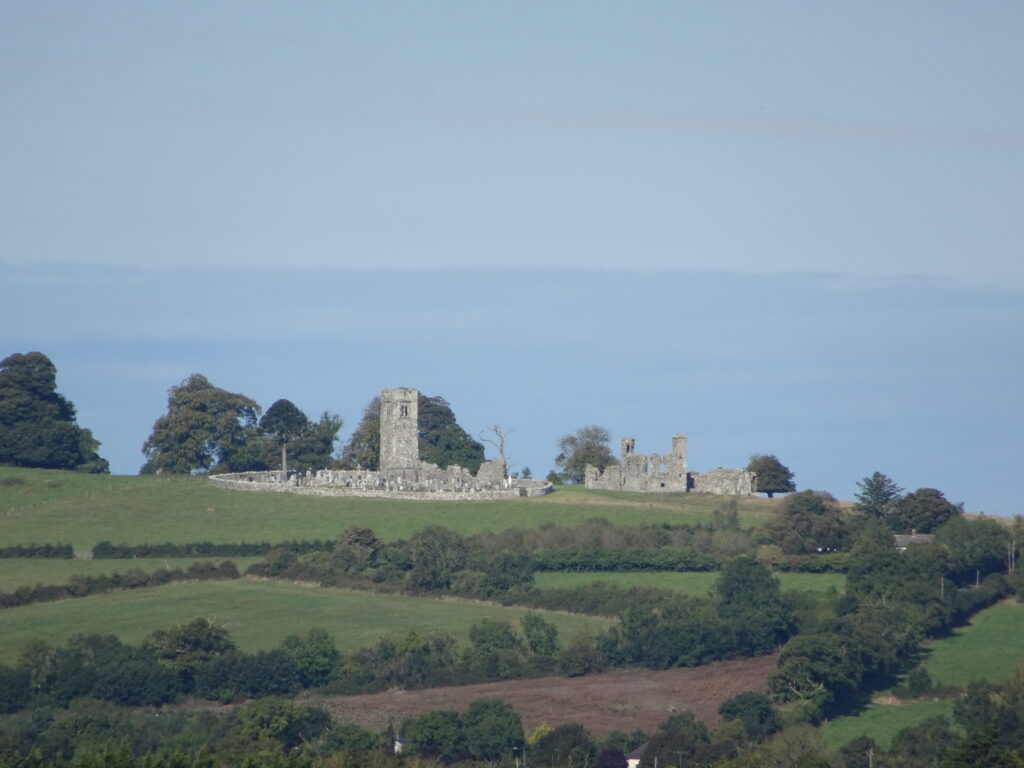
After descending the stairs I met back with Michelle and we looked at some of the smaller mounds and a recreation of a wood henge, an area where logs were stood upright in a circular pattern. Archaeologists know one was there and the positions based on finding the holes in which the logs were placed.
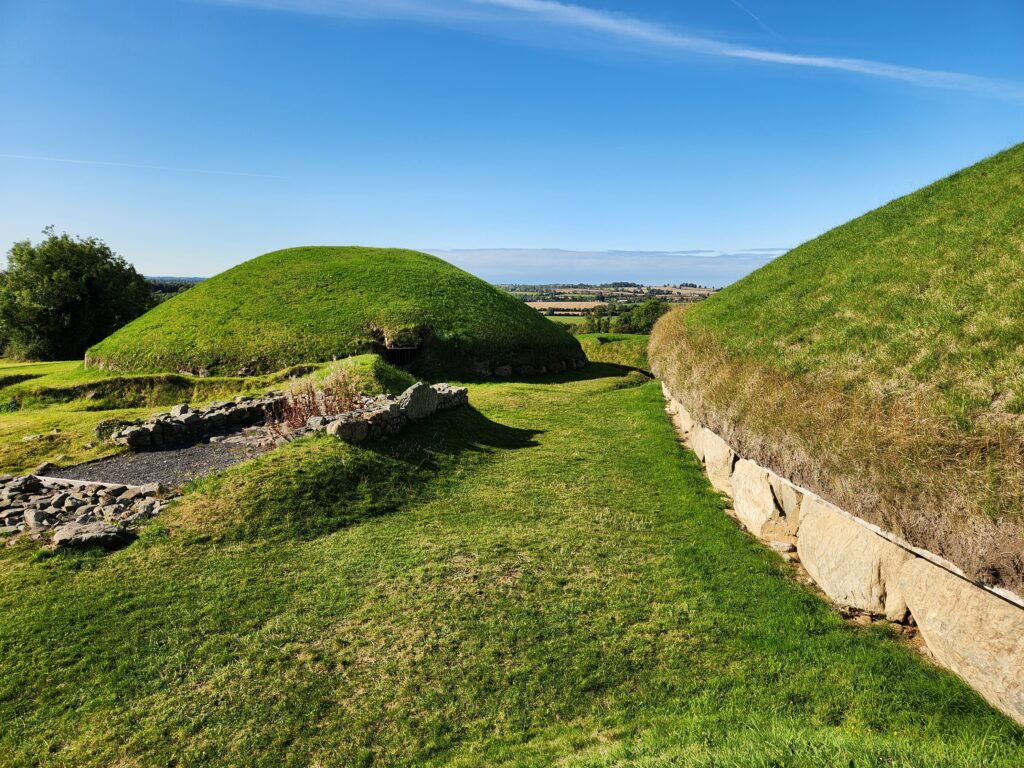
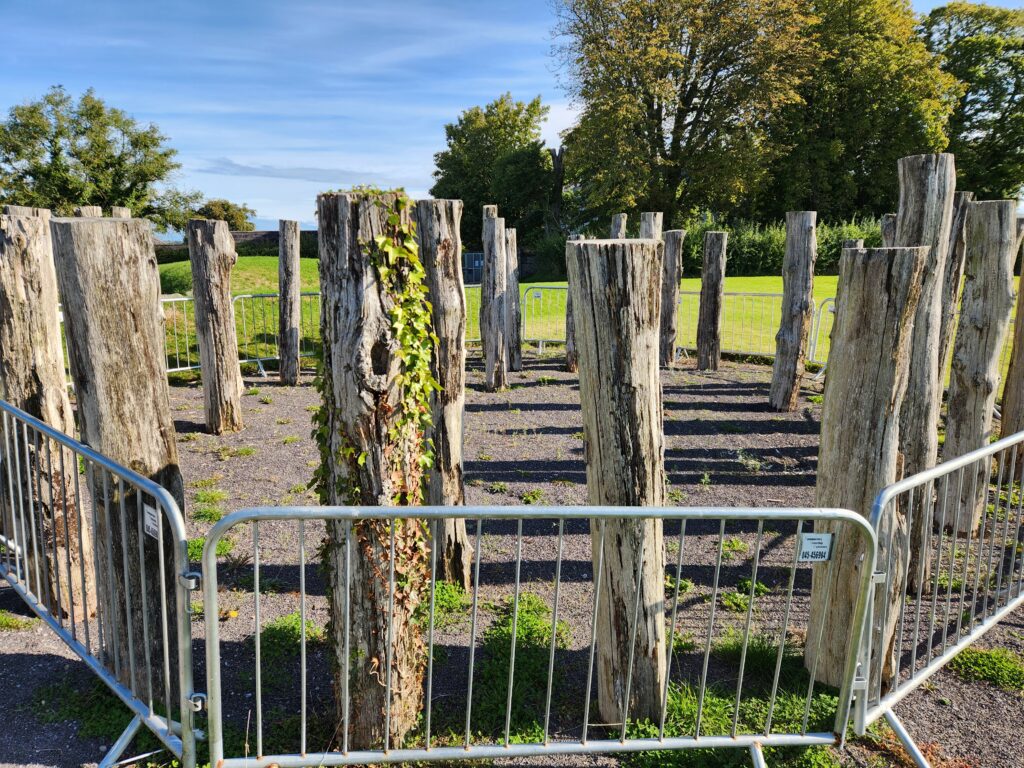
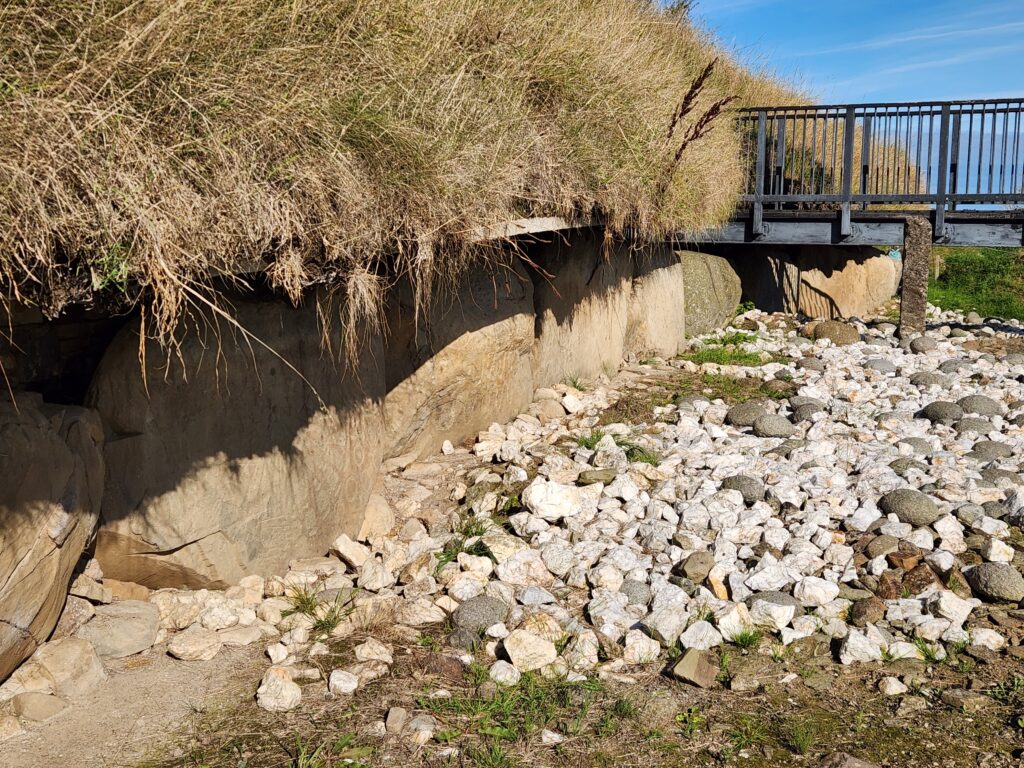
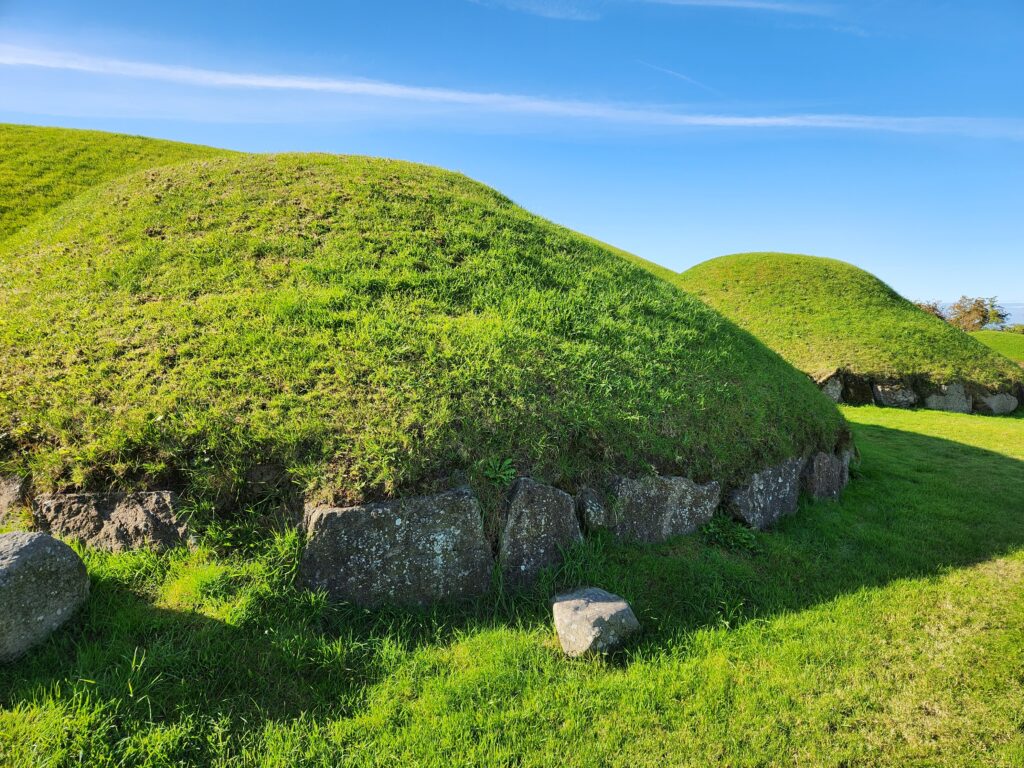
I asked our guide whether goats and sheep were used to keep the grass short at the top of the mound. Turns out they would damage the mound too much, instead a very expensive robotic mower called “The Spider” is used. We all met back at a small visitors’ center at 10:45am and watched a short fifteen minute AV presentation before boarding our busses at 11am. A short drive later we were at Newgrange with a new guide (either Emma or Emily, I can’t remember).
Though also a Stone Age portal tomb built around 3200BC Newgrange felt distinct from Knowth. While bigger (the same height but nearly 280 feet in diameter) it lacks the satellite mounds but is surrounded by twelve standing-stones (likely added much later during the Bronze Age). Also a facade of white quartz stones was restored to their (likely) original position around the perimeter of the mound.
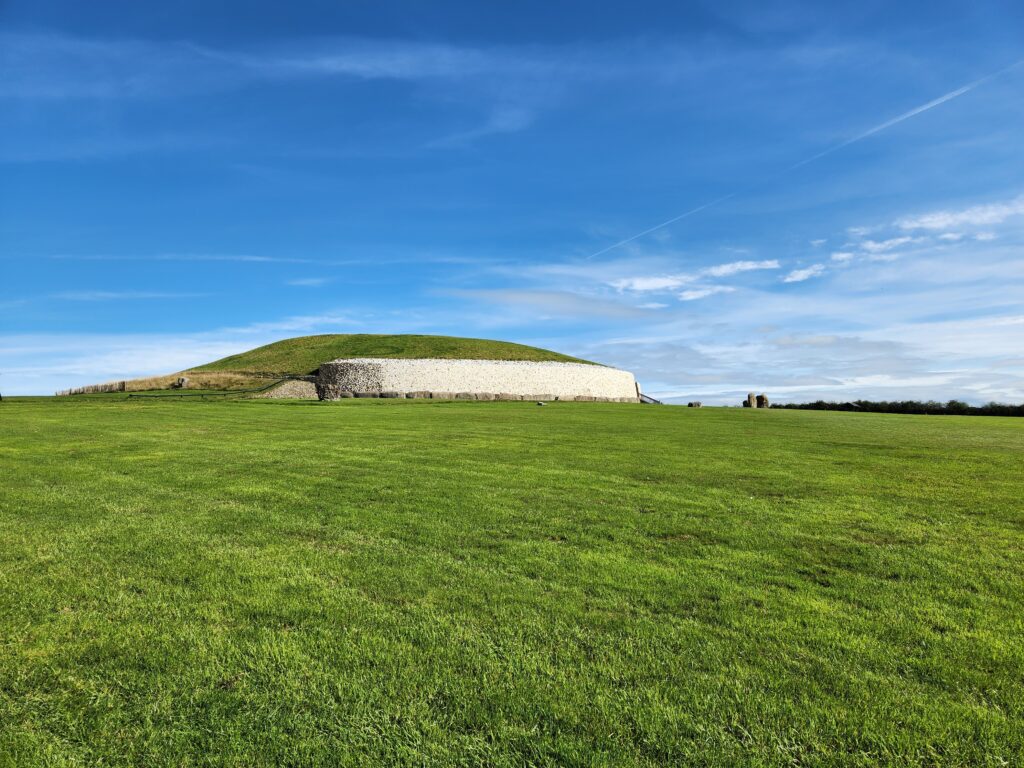
Newgrange was not just a tomb but also a ritual center. There is a passage and above the entrance a smaller square “window”. Unlike Knowth, we got to go within. It was quite narrow, and at one point I had to turn sideways (as my shoulders were too wide) and duck (as it was about four feet tall) — I thought I was going to get stuck! The passage proceeded for about sixty feet and ended with a chamber. The chamber had three alcoves, each with a basin stone. One of the basin stones was cracked in more modern times but the other two were intact. These basins supported the cremated remains of (presumably) the rulers of this society.
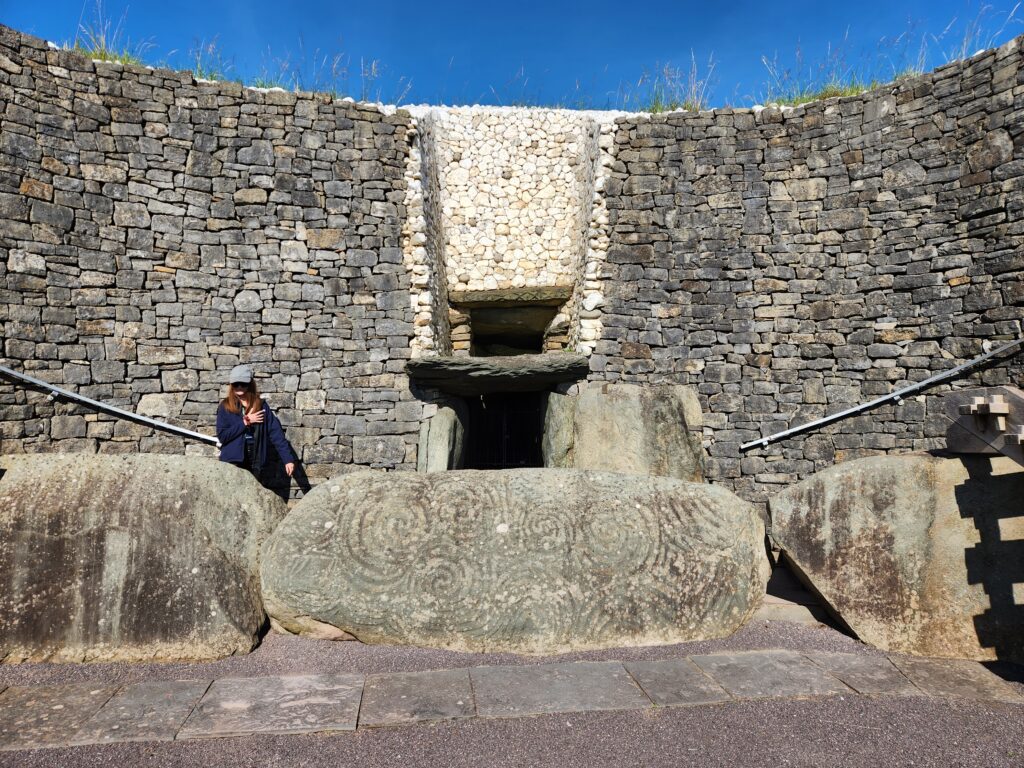
Newgrange is also remarkable in its construction because on the winter solstice the rising sun shines through the aforementioned window and penetrates all the way to the chamber sixty feet within. Remarkable what our ancestors were able to work out and accomplish. Though we weren’t there at the solstice we were in for a treat. Our guide turned off the lights and, while we waited in pitch darkness, a shaft of light worked its way down the passage. Though not the real thing, nor as bright, it was transcendental. We could feel a connection to a people that, having just started to settle down with the domestication of wheat, could focus on building such remarkable spiritual centers.
There were some fantastic carvings — spirals and triangles and such. There was also some more modern grafitti spanning the tomb’s modern discovery in 1699 through the late 1800s when conservation began in earnest. The discovery in 1699 was a bit of a miracle — the farmer had sent some people out to dig for stones in the hill on his property and by luck they hit the passage entrance immediately. Most amazing to me is the high (eighteen foot) stone roof that narrows as it ascends (like a beehive). This marvel has never leaked in nearly 5000 years (though the dirt atop certainly helped there as well). One of the other visitors asked about a little bit of green that appeared here and there. Sadly, it was a result of visitors like us bringing in moisture via our breath.
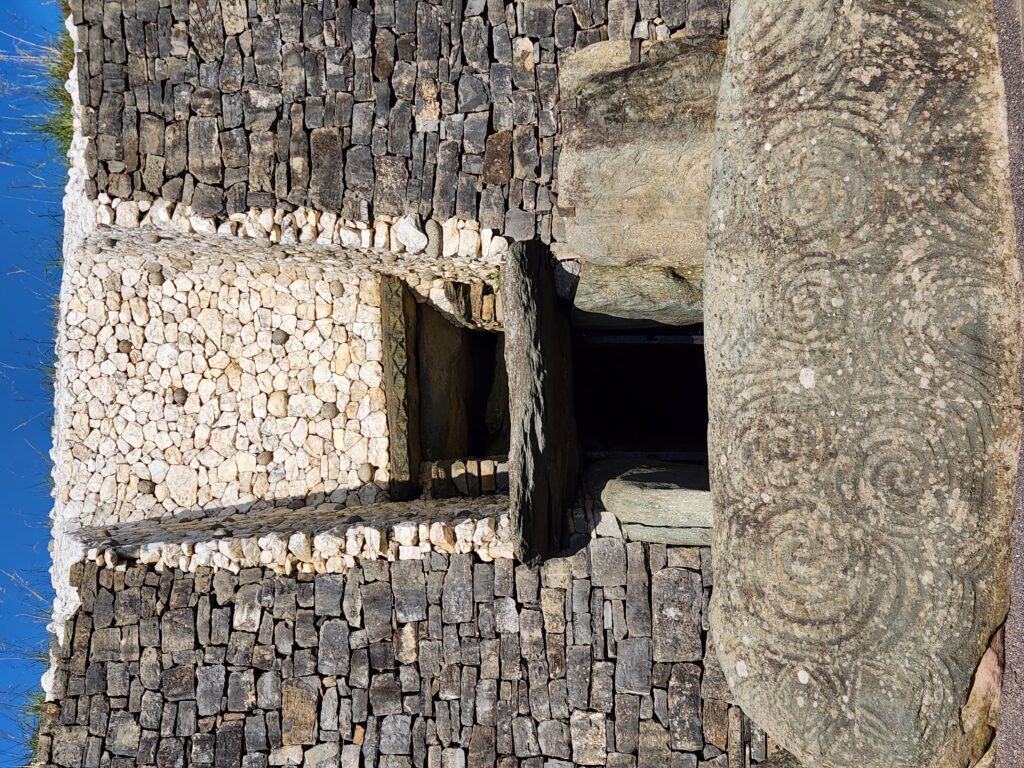
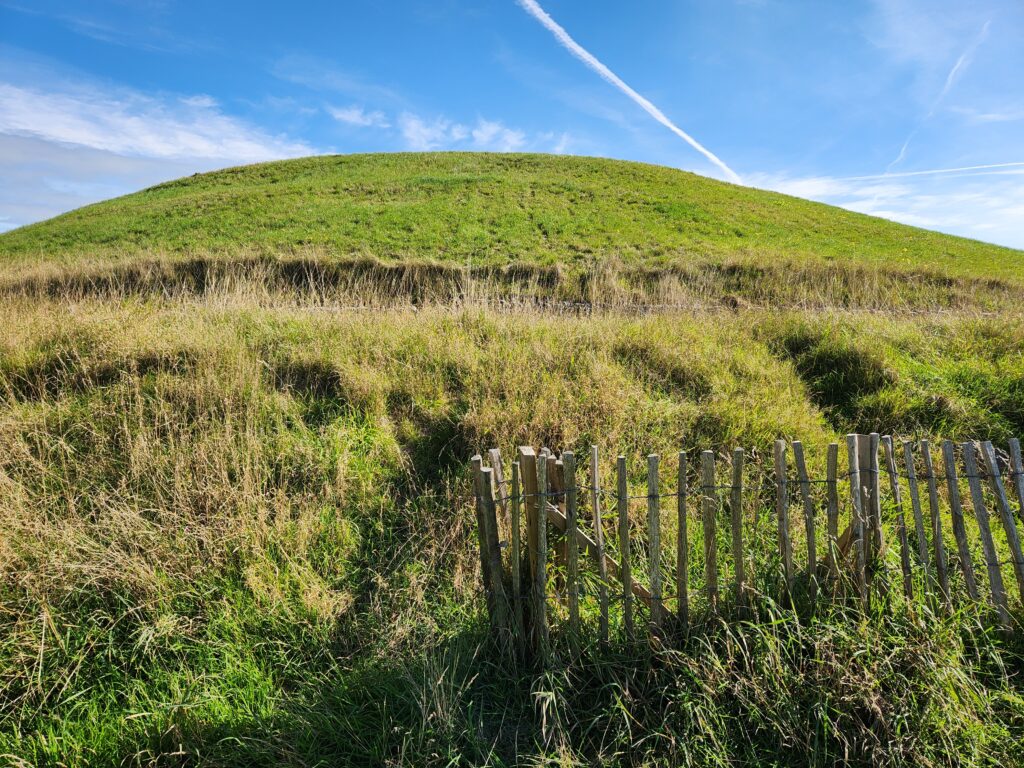
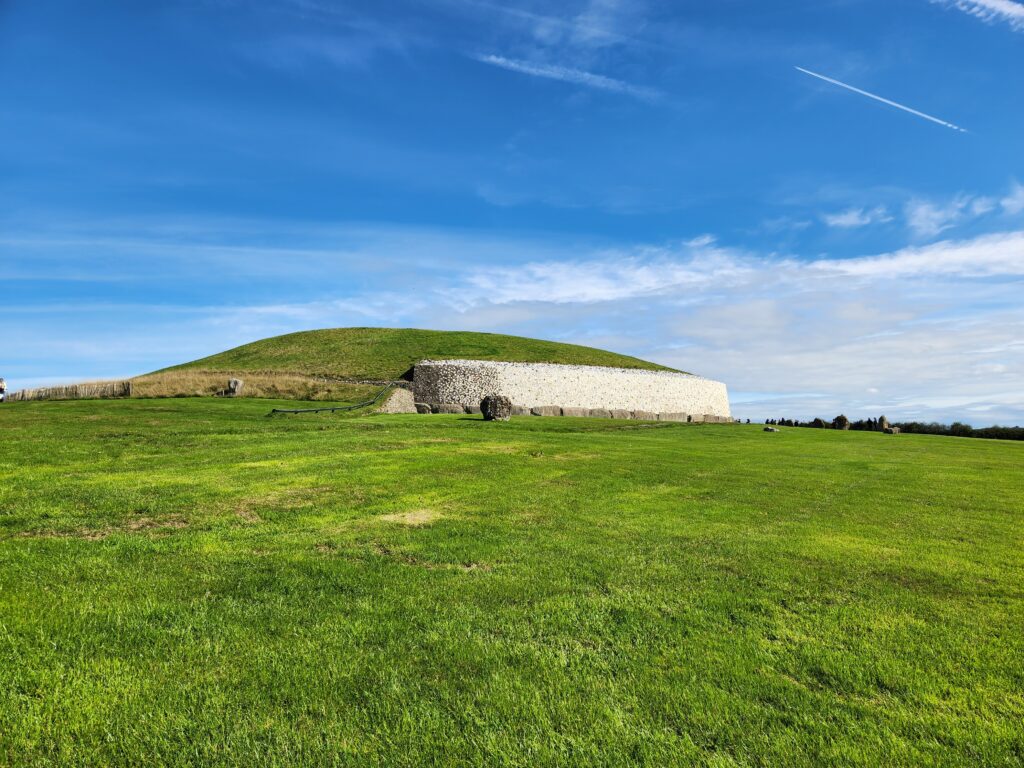
After exiting we walked around a bit more and headed back to the bus at 11:45am. Back at the visitors’ center at noon we met back up with Damien. He told us that he was able to be there a few years back during the solstice. I can’t imagine how cool that must’ve been!
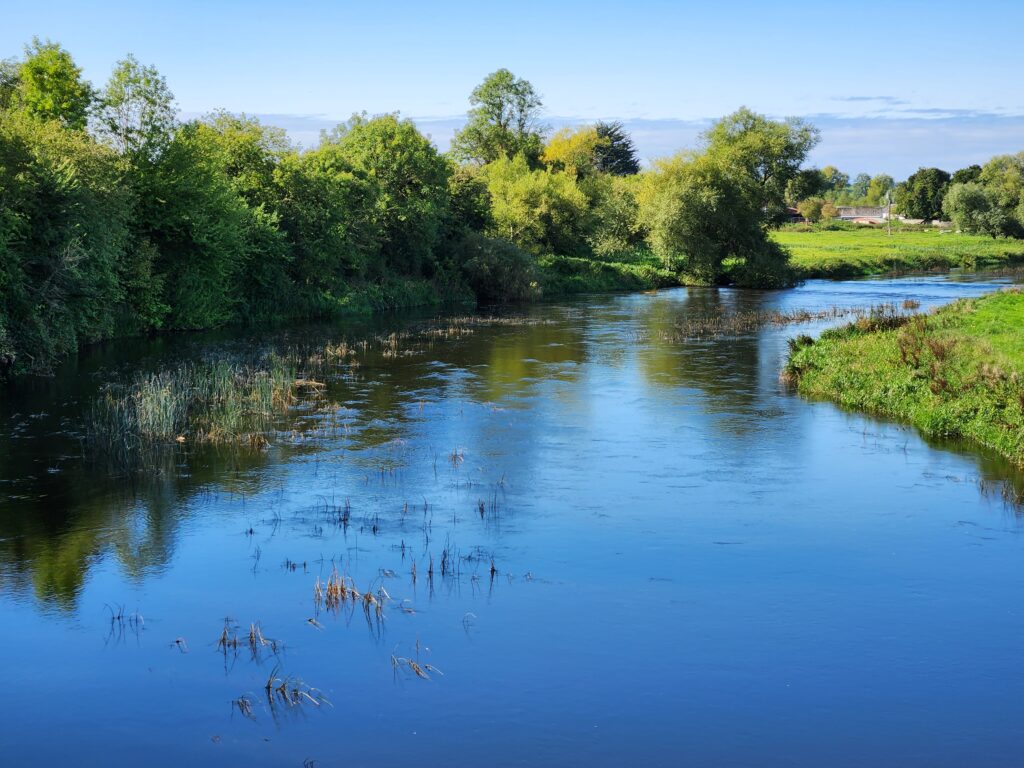
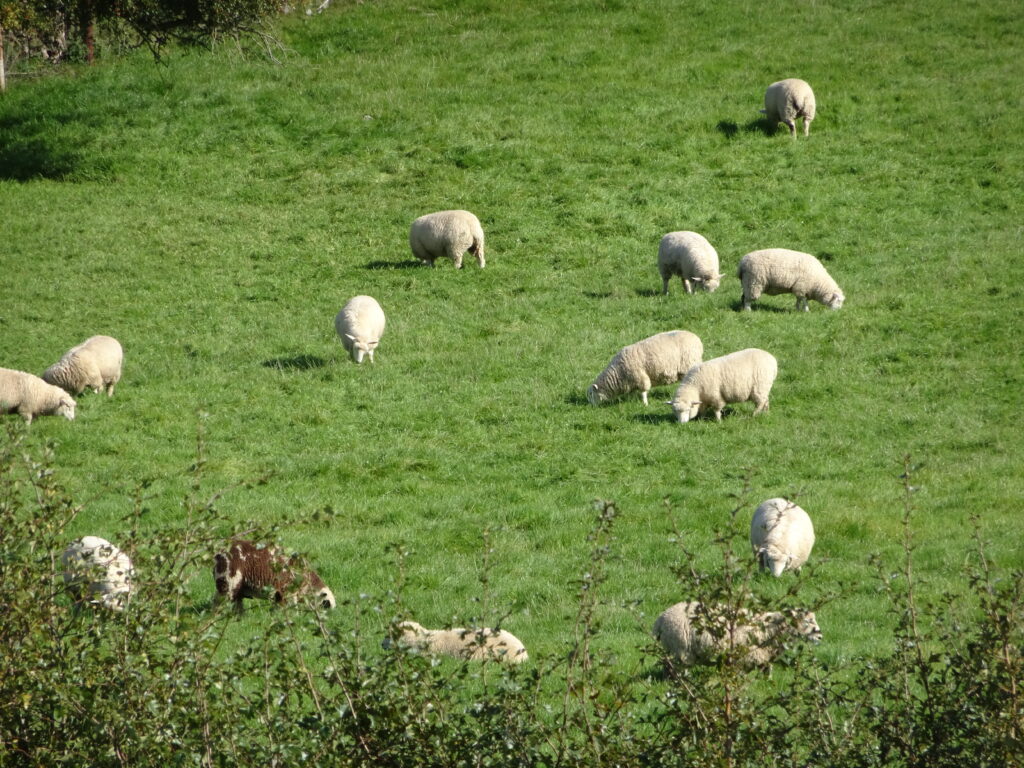
Our last destination was Monasterboice, an early Christian monastic settlement from the late 400s AD (so contemporary with the Fall of Rome (476AD)). Amazing! What drew me to Monasterboice is the excellent high crosses and Celtic crosses as well as the remains of a round tower.
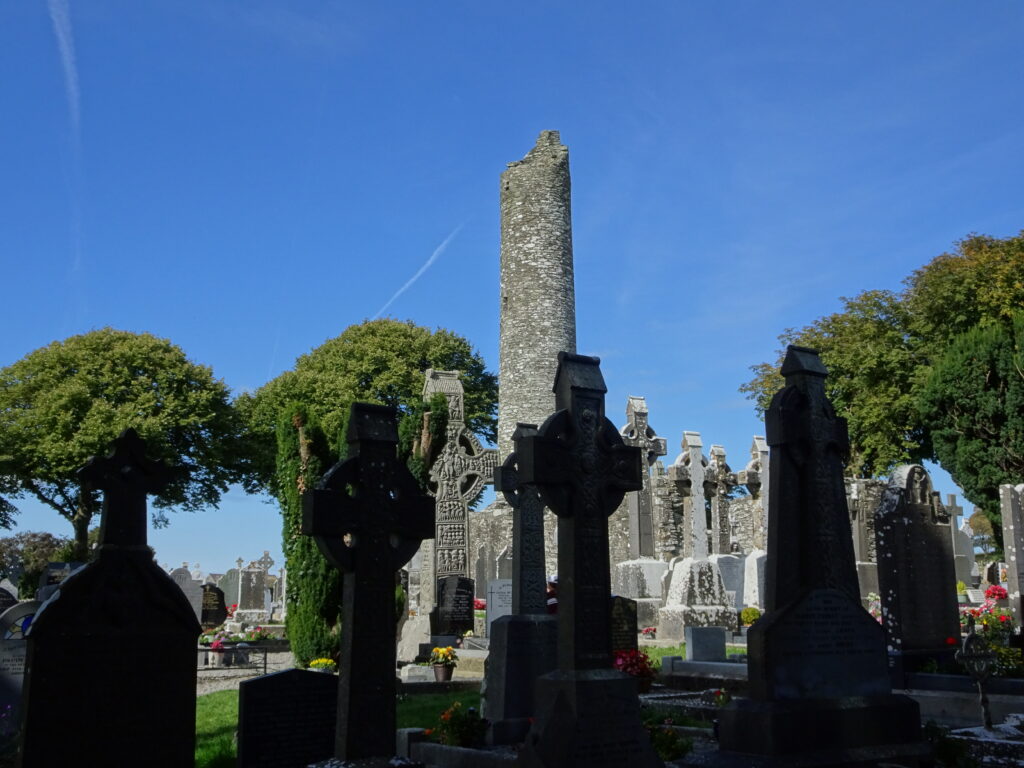
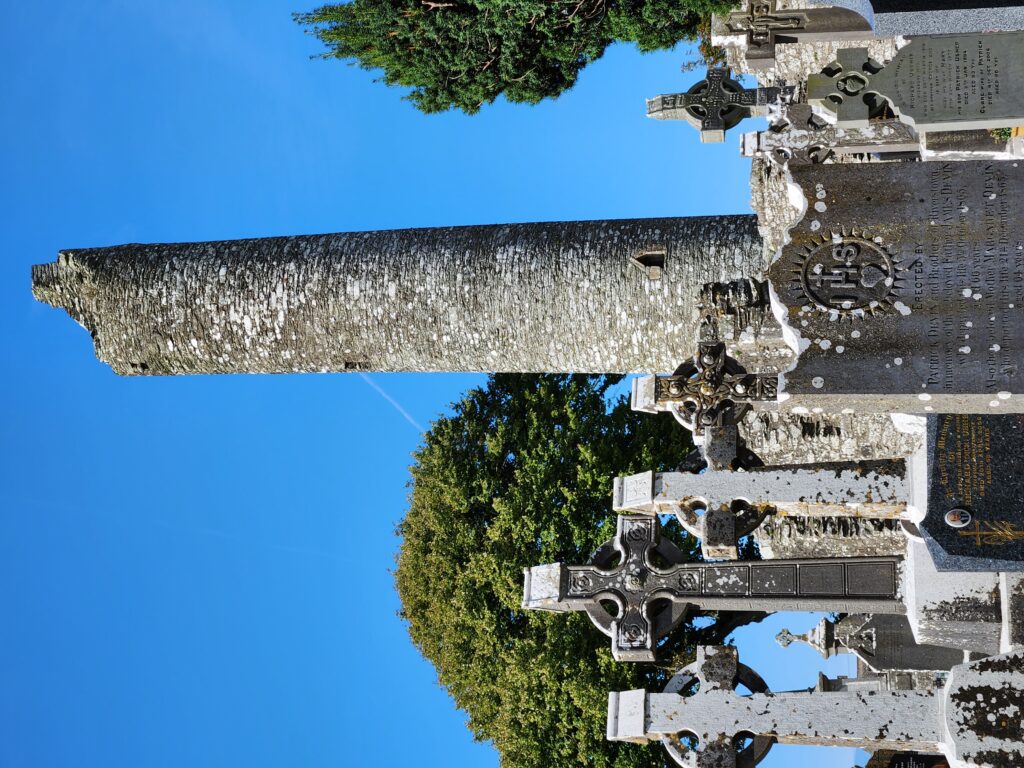
The round tower was built around 1000AD and is about 80 feet tall but lacks the conical top typical of similar settlements. Damien stressed that the tower very likely wasn’t used as protection against Vikings and the like but rather for storage and as a lookout.
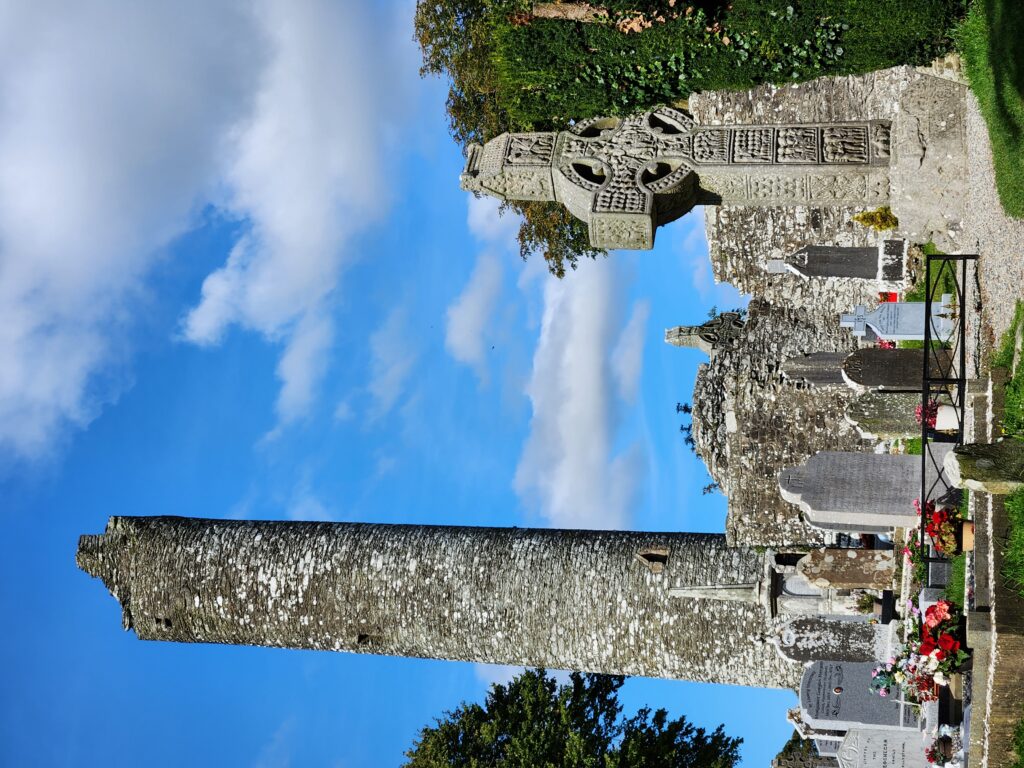
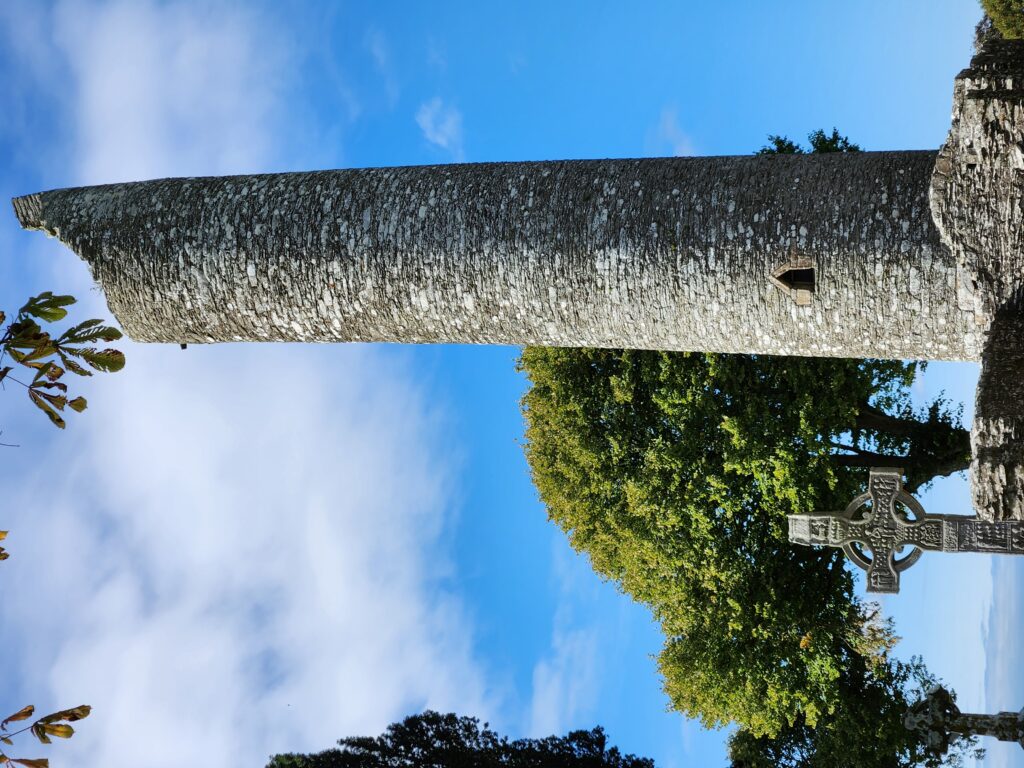
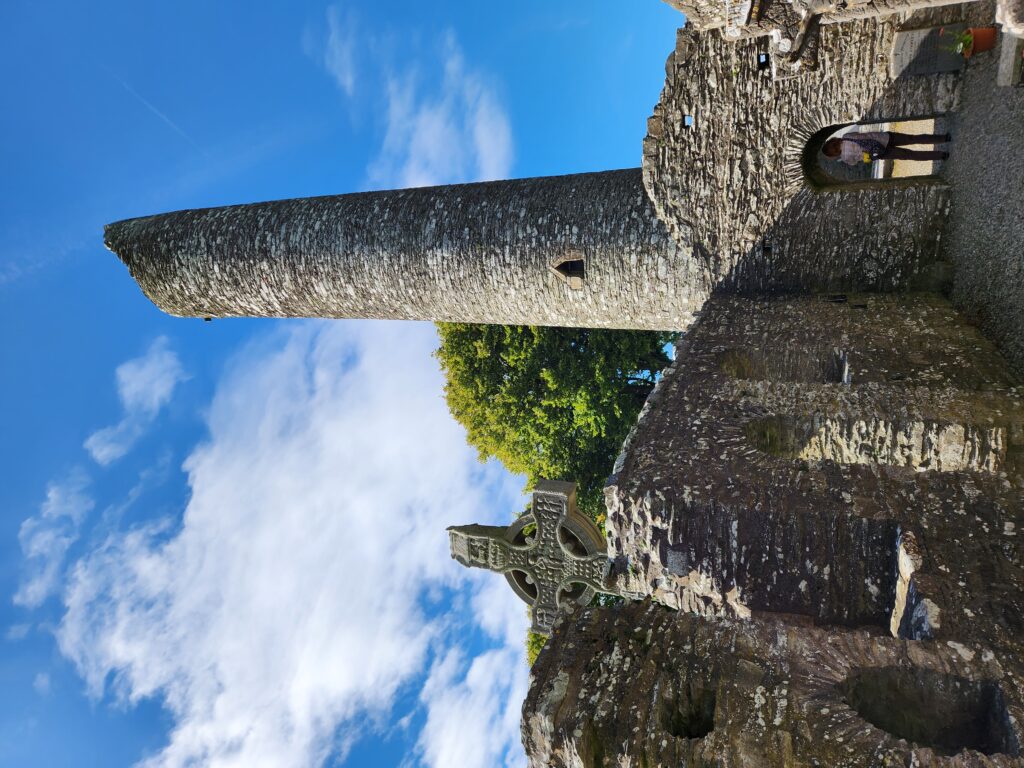
The high crosses dated a bit earlier, likely the 900s AD. The tallest, at over sixteen feet, is considered the finest high cross in Ireland. It has carvings of both the Old and New Testaments. While a bit worn due to over a millennium exposed to the elements the details are still visible. Damien stressed that while the high crosses are beautiful art they were first and foremost meant to teach to a mostly illiterate populace. As such it was brightly painted with easily discernable figures from the Bible. One particularly neat detail was Christ in the center of the cross with people facing him on one side and others facing away from him — with a figure with a pitchfork behind them.
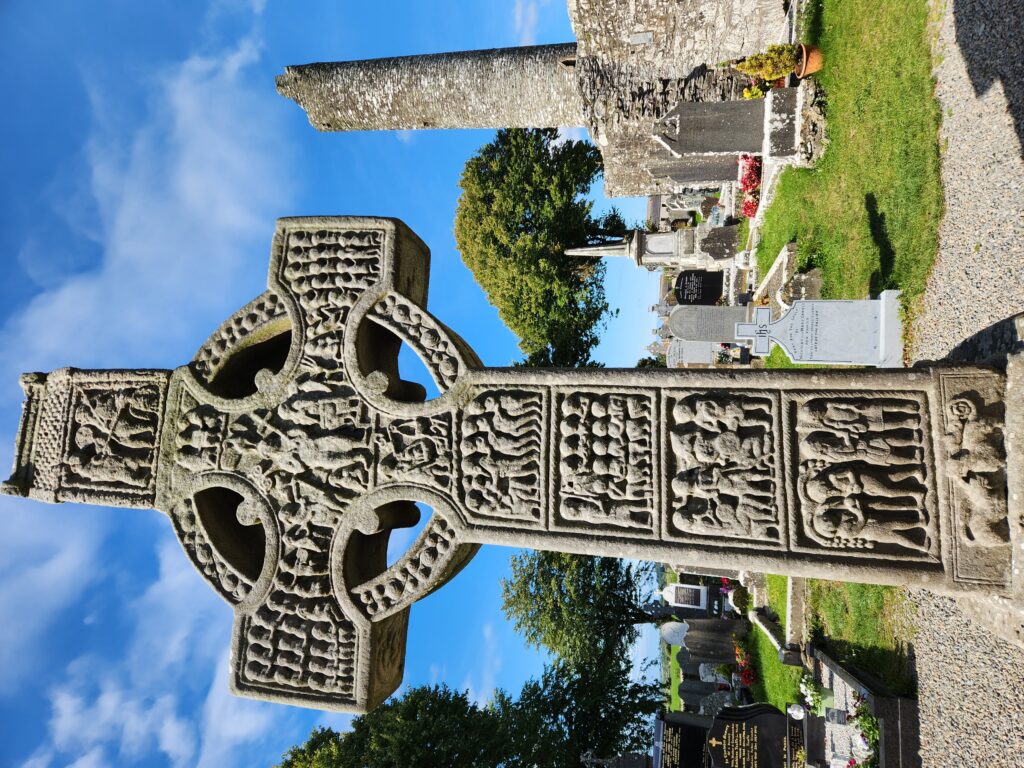
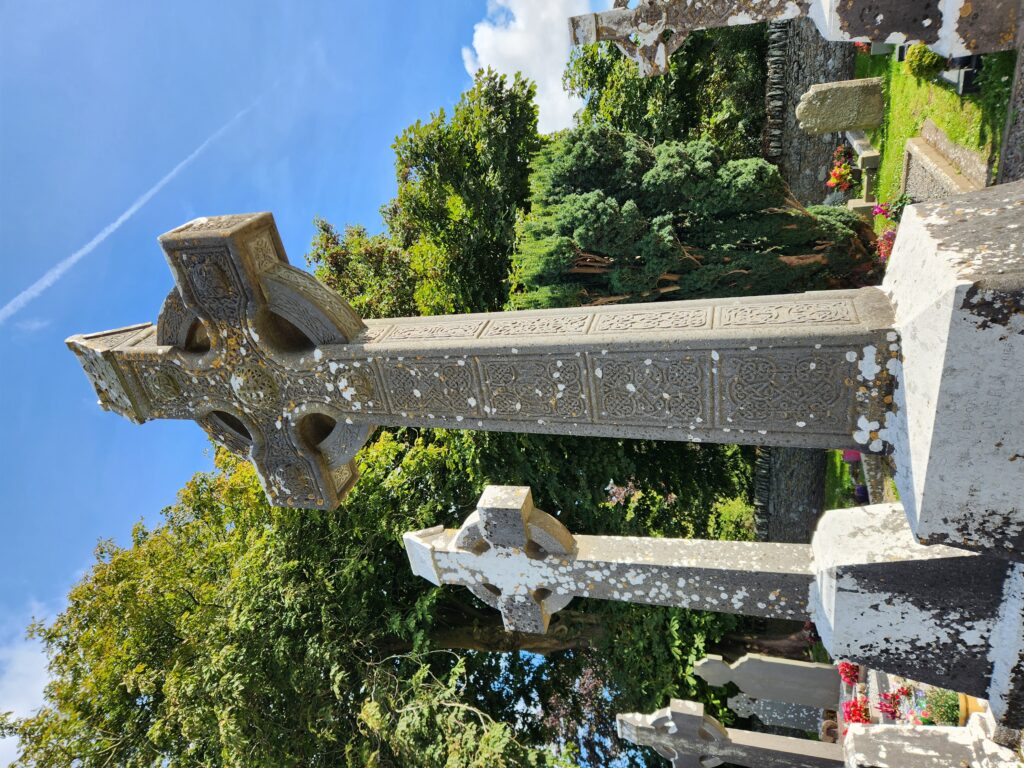
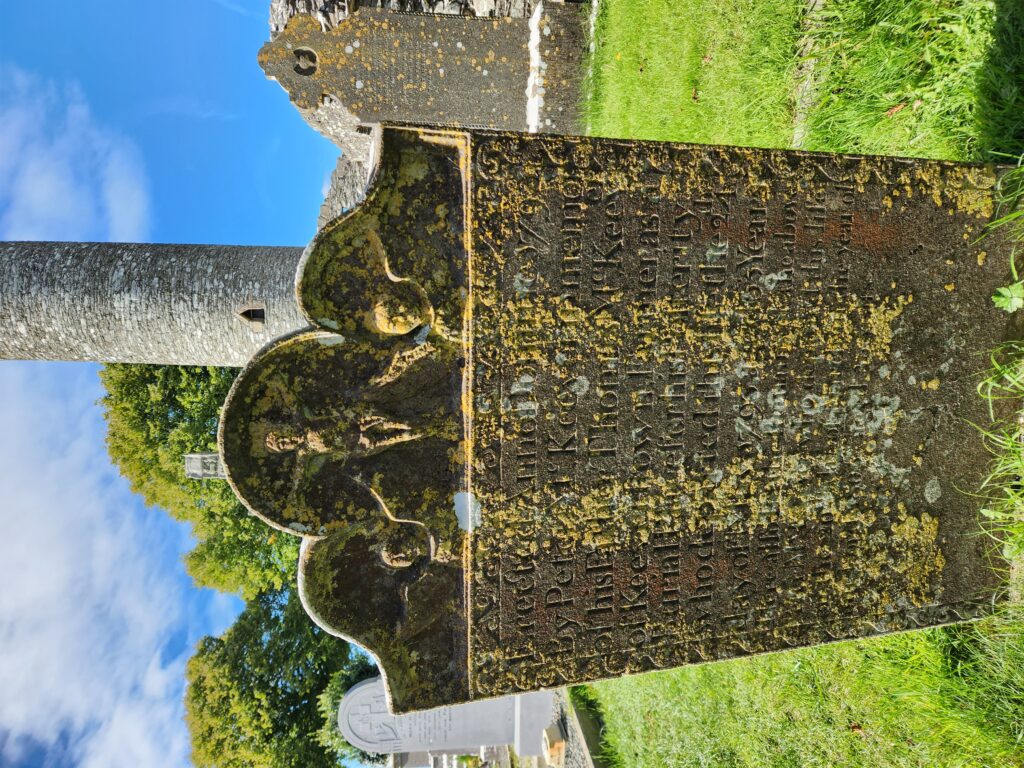
On the way back Damien showed us where the former President of Ireland lived and the pub where he’d often entertain world leaders. We also talked a bit about The Troubles. Damien had a unique perspective on that period (that I won’t go into as that’s his personal information) and it was really special to have his insight on the time and the following peace. He is very optimistic for the future of Ireland and noted that the youth are very willing to leave the past behind. A fascinating thing he mentioned was that one can tell even today where car bombs went off in Belfast as the damaged stone buildings were replaced with modern glass edifices.
We arrived back at the hotel just before 2pm and, after freshening up a tiny bit, headed out for lunch at the Irish Potato Cake Company. Michelle had potato soup with bread but the soup was onion-y and the bread was seed-y so she didn’t enjoy it much. She also had some lemon “cheesecake” that was a bit strange. I, however, really enjoyed my meal. I had three bacon and cheese and three Guiness beef potato cakes. They were wonderful, but I definitely favored the bacon and cheese. I also had some of the “cheesecake”. It was OK. We finished up by sharing tea from a pot with a cute cozy atop.
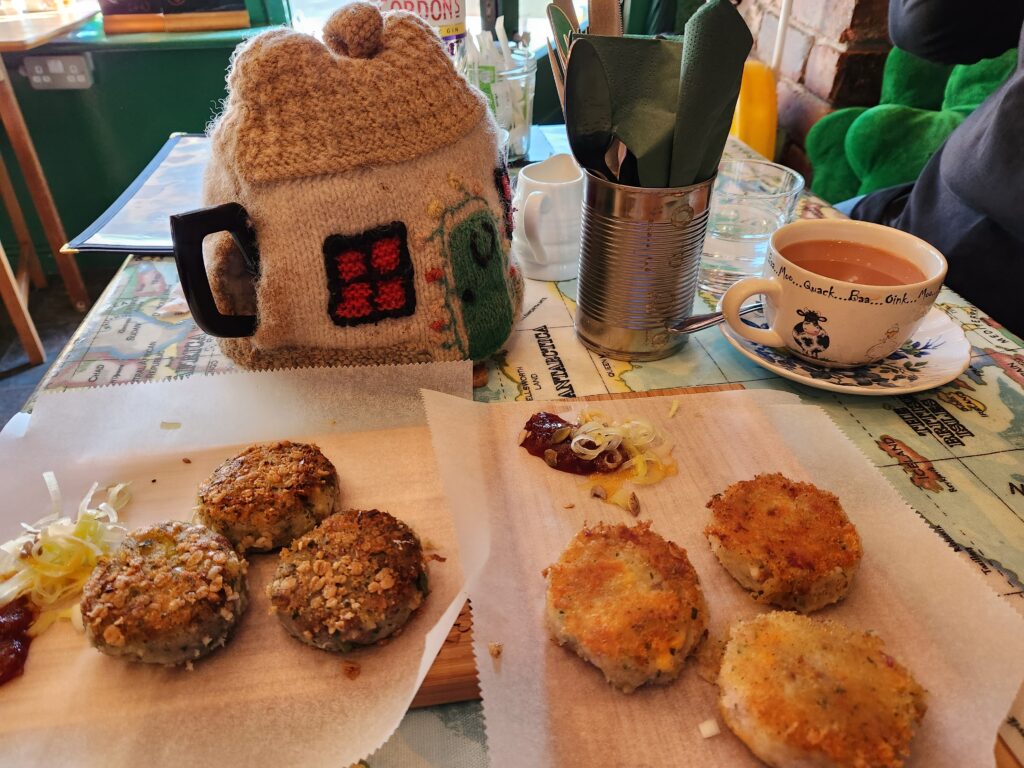
We crossed over Ha’penny Bridge to Forbidden Planet to do some shopping. We got a couple of small things then some water at Starbucks (yeah, they are everywhere — except Italy) and went to a couple of tourist stores hoping to find an Irish solar dancer (to no avail). We swung by The Rolling Donut for three donuts (two Coffee Lovers and one glazed) on the way back to the hotel by 5:30pm.
After lazing around until 7:45pm we headed down to the basement of the hotel for our 8pm dinner show Celtic Nights. We were seated at a table with others not too far from stage left. Dinner was really good. Michelle had tomato soup and brown bread, chicken (without wine gravy and onions), and some kind of parsnip mash that she enjoyed. I had fresh fruit, Irish Guinness beef stew with mashed potatoes and some kind of crunchy substance — onions? — atop. It was great. Dessert was an assortment of mini-cakes that was decent but didn’t meet the high standard of the main course.
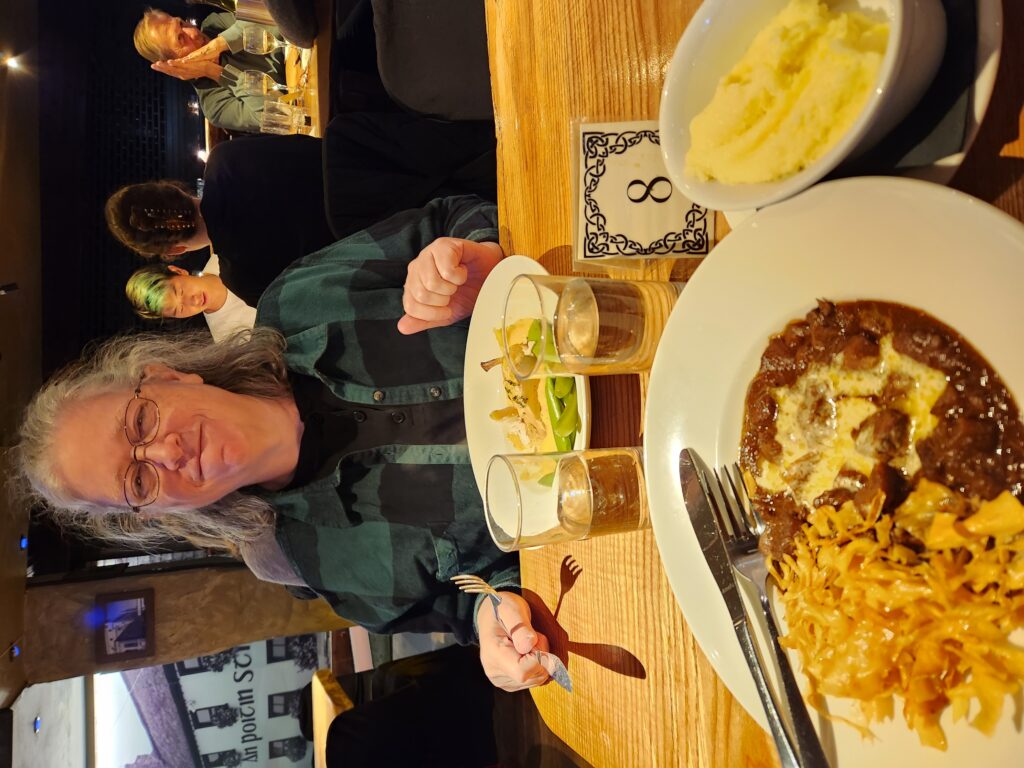
Shortly after we finished dinner four musicians came on stage — one with bass, another guitar, another fiddle, and the last doing pipes and flute. They played a variety of Irish traditional songs — from “Molly Malone”, “The Fields of Athenry”, etc. to very touching ones about the Irish fight for independence, including a very affecting one, “Grace”, about one of the heroes (Joseph Plunkett) being allowed to marry just moments before facing the firing squad.
At regular intervals two female and two male Irish traditional dancers came out to dance to beautiful instrumentals. They were great. The musicians, particularly the lead singer, also interacted with the crowd regularly — asking where people were from and even incorporating one guys “yeaaaaah!’ into the chorus of one of their songs.
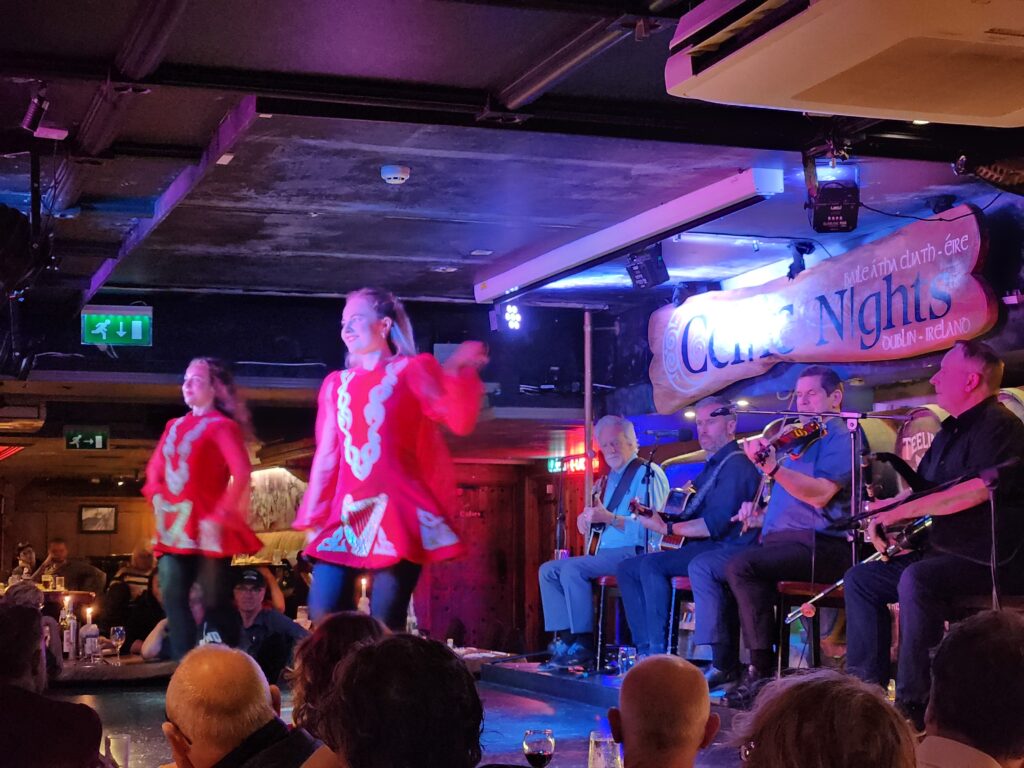
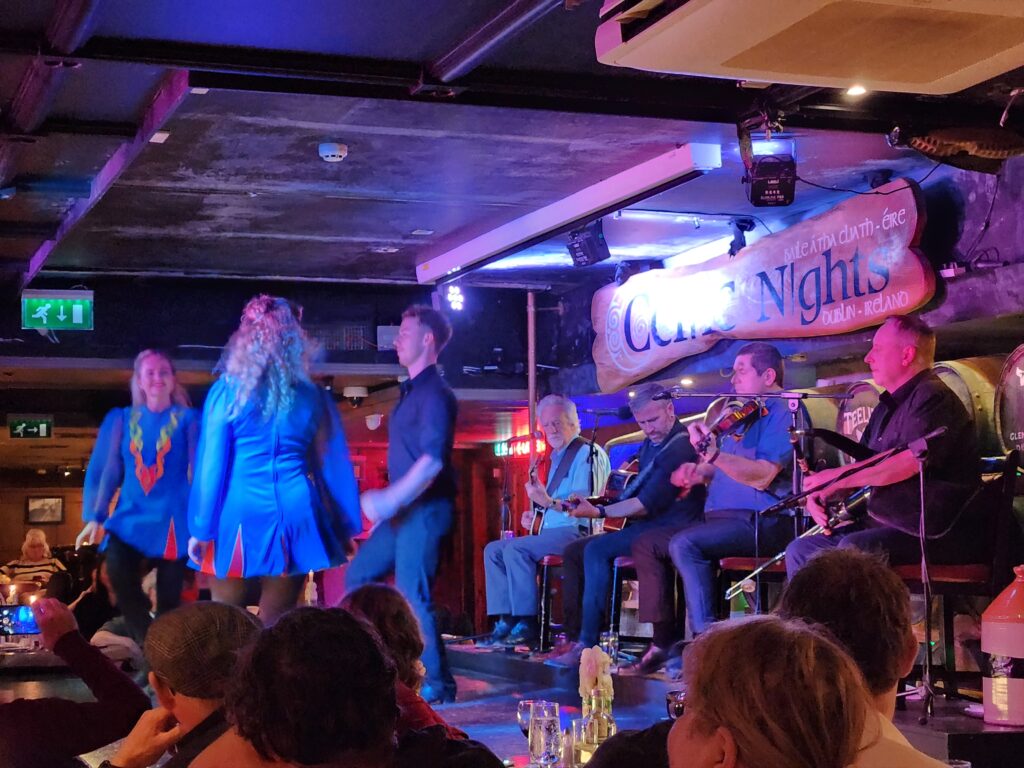
The show wrapped up around 10:30pm. While it is a shame we had to rely on a hotel dinner show to finally get traditional music and dancing it was very good and we were grateful we did it. We headed upstairs and I offloaded pics and packed and laid in bed around midnight.